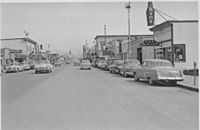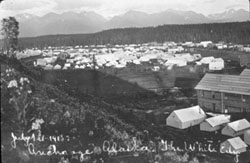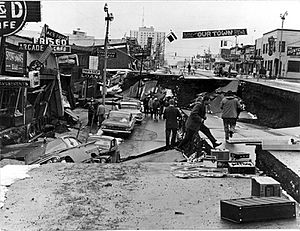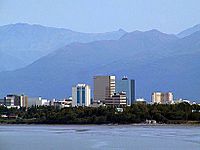History of Anchorage, Alaska facts for kids
Anchorage, Alaska, started as a small settlement in 1915. It was first a tent city near Ship Creek. This new town was planned to be a port and a main stop for the Alaska Railroad. For many years, Anchorage was mostly a "company town" for the railroad workers.
Alaska's important location led to many military bases being built during World War II. This military presence, along with new resource discoveries, helped Anchorage grow a lot. Its population and economy have been booming since the 1940s.
In 1964, a huge earthquake hit Alaska. It destroyed or badly damaged many parts of Anchorage, especially downtown. But the community quickly rebuilt. Today, Anchorage is a major city in the United States.
Contents
Alaska's Early History: From Russia to U.S. Territory
Long ago, in the 1800s, Russia had a strong presence in south-central Alaska. But in 1867, the U.S. Secretary of State, William H. Seward, made a big deal. He bought Alaska from Russia for $7.2 million. That's about two cents for every acre!
Many people made fun of this deal. They called it "Seward's folly" or "Seward's icebox." But later, in 1888, gold was found near Turnagain Arm. This showed that Alaska was full of valuable resources. In 1912, Alaska officially became a territory of the United States.
Growing Up: Anchorage from 1930 to 1964
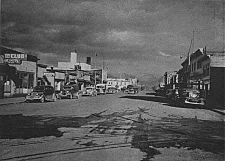 |
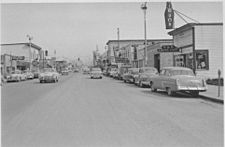 |
|
|
Fourth Avenue, a main street, in 1944 (left) and 1953 (right). Both views look towards the Fourth Avenue Theatre and the Federal Building.
|
||
Between the 1930s and 1950s, air travel became very important for Anchorage. In 1930, a new airport called Merrill Field opened. It quickly became one of the busiest civilian airports in the country. Then, in 1951, Anchorage International Airport opened. This airport became a key stop for planes flying between Europe and Asia.
The U.S. military also grew a lot in Alaska starting in the 1940s. Large bases like Elmendorf Air Force Base and Fort Richardson were built. Anchorage became the main base for the Alaska Defense Command. The military invested a lot during World War II because of the threat from Japan. This continued into the 1950s due to the Cold War.
As the military grew, so did Anchorage. Between 1940 and 1951, the city's population jumped from 3,000 to 47,000 people. Anchorage started to look more like a real city. The first traffic lights were put up in 1949. The Seward Highway opened in 1951, making travel easier. In 1953, KTVA became the city's first television station. A year later, Alyeska Resort was built, offering fun in the snow.
On January 3, 1959, Alaska officially became the 49th state of the U.S. After this, Anchorage faced a big housing problem. Many new homes were built in the suburbs to help. In 1964, Anchorage became a City and Borough, which is a type of local government.
Anchorage has also tried to host the Winter Olympic Games several times. The most recent attempt was for the 1994 Games.
The "Good Friday Earthquake"
On March 27, 1964, at 5:36 PM, a massive earthquake hit Anchorage. It caused huge damage. This earthquake had a magnitude of 9.2. It was the largest earthquake ever recorded in North America. Anchorage was only about 75 miles (120 km) from where it started.
The earthquake killed 115 people in Alaska. The damage cost over $300 million, which would be about $1.8 billion today. It was the second-largest earthquake in recorded history worldwide. Anchorage spent much of the late 1960s rebuilding after this terrible event.
Rebuilding and Oil Discovery: 1965 to 1999
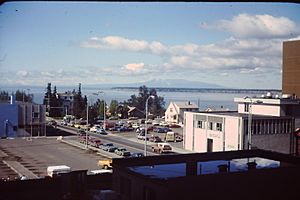
In 1968, a huge discovery was made: oil was found in Prudhoe Bay in northern Alaska. In 1969, the state made billions of dollars from selling oil leases. Then, in 1974, work began on the Trans-Alaska Pipeline System. This giant pipeline was finished in 1977 and cost over $8 billion.
The oil discovery and pipeline construction brought a new boom to Anchorage. Many oil and construction companies set up their main offices there. The Anchorage International Airport also grew a lot. Anchorage started calling itself the "Air Crossroads of the World" because of its great location for flights.
In 1975, the city and borough joined together to form one unified government. This new area became known as the Municipality of Anchorage. It included other communities like Eagle River, Eklutna, Girdwood, and Glen Alps. By 1980, Anchorage's population had grown to 184,775 people.
The 1980s started with a lot of growth. Money from the North Slope oil flooded into the state. This allowed for many new projects. Anchorage built a new library, a civic center, a sports arena, and a performing arts center. They also improved places like Hilltop Ski Area and Kincaid Outdoor Center. These projects made the city better and improved the quality of life. However, in the late 1980s, the price of oil dropped a lot. This caused a recession in Anchorage.
In 1996, the Arctic Winter Games were held in Chugiak/Eagle River. In 1999, the Alaska Native Heritage Center opened. This center helps people learn about Alaska's native cultures.
Anchorage in the 21st Century
On July 8, 2000, the airport was renamed "Ted Stevens Anchorage International Airport". This was to honor Ted Stevens, who was Alaska's longest-serving U.S. Senator.
Today, Anchorage is still growing. While some areas are filling up, there are still many undeveloped spaces. The city also has large parks and greenbelts, which are natural areas kept for recreation.



